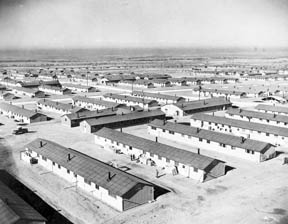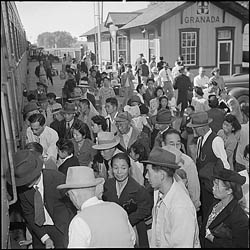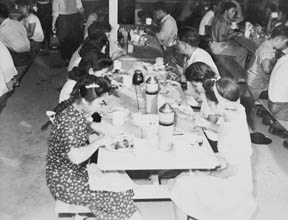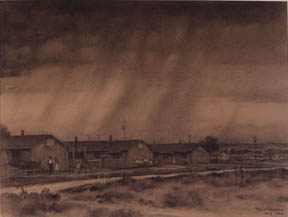America’s Concentration Camps
Amache
August 27, 1942 – October 15, 1945
“Well, when I first got there, it was sort of a challenge, you know…. But it was getting by, working, making friends, and trying to learn something while you are doing all this.”
—Esther Nishio
Amache was built on a dusty hilltop in southeastern Colorado, near the town of Granada. Like other camps, it was built from scratch, on land that was empty of buildings and devoid of infrastructure. Yet within months of opening, it became, in effect, a city, with the largest population in the area. It had police and fire departments, a 150-bed hospital, a public library, a newspaper, and stores. Though Amache was the smallest of the concentration camps, housing 7,597 at its peak, it was the tenth largest city in Colorado.
Camp Jobs
The War Relocation Authority (WRA), the civilian organization tasked with managing the camps, provided jobs for about half the inmates at Amache, who ran most of the camp’s day-to-day affairs. Wages were $12 per month for unskilled labor, $16 per month for skilled labor, and $19 per month for professionals such as doctors.
These were meager wages indeed, but local communities hard-hit by the Great Depression were often resentful that the government was providing jobs for inmates at all. The WRA tried to quell the public’s rancor in the brochures it distributed about the camps, emphasizing inmates’ hard work and sacrifice, and the camps’ overall productivity.
Beautiful Celery
Half the inmates at Amache had been farmers from central California. Min Tonai, an inmate from the city, didn’t know what to make of them at first:
The guys were in bib overalls, the teenagers were in bib overalls, red bandana on the neck, and a straw hat. And clod hoppers. For us, what was this? Some of our guys were wearing zoot suits. And I wondered, why didn’t they keep the city folks together? And then it hit me. We [city folk] were just fill. They wanted the farmers to farm all that land, ’cause those central California farmers were superb farmers.
The WRA had bought or confiscated 10,500 acres of farm and ranch land for the camp. The clay soil wasn’t promising. “One farmer came from Tule Lake,” remembered Tonai, “and he said, ‘I’m gonna take that four acres and produce celery.’ And the other Japanese farmers said, “You can’t raise celery here.’ [He] says, ‘I can do it.’ Beautiful Utah-type celery. Beautiful celery he raised.”
In fact, Amache farmers raised bumper crops of alfalfa, corn, and sorghum, as well as lettuce, celery, spinach, onions, and lima beans. They grew so much food during the wartime shortage, that they were able to export railroad carloads of grain and produce.
Quote credits
Esther Nishio, REgenerations, Los Angeles, Vol. 2,
p. 316
Min Tonai, interview by Tom Ikeda,
September 2, 2010, Densho Visual History Collection,
Densho.
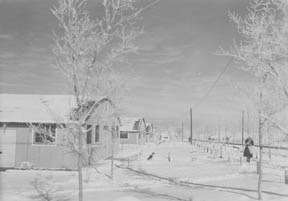 Enlarge
Enlarge
Amache administration building. Gift of the Yamamoto Family (98.54.8).
